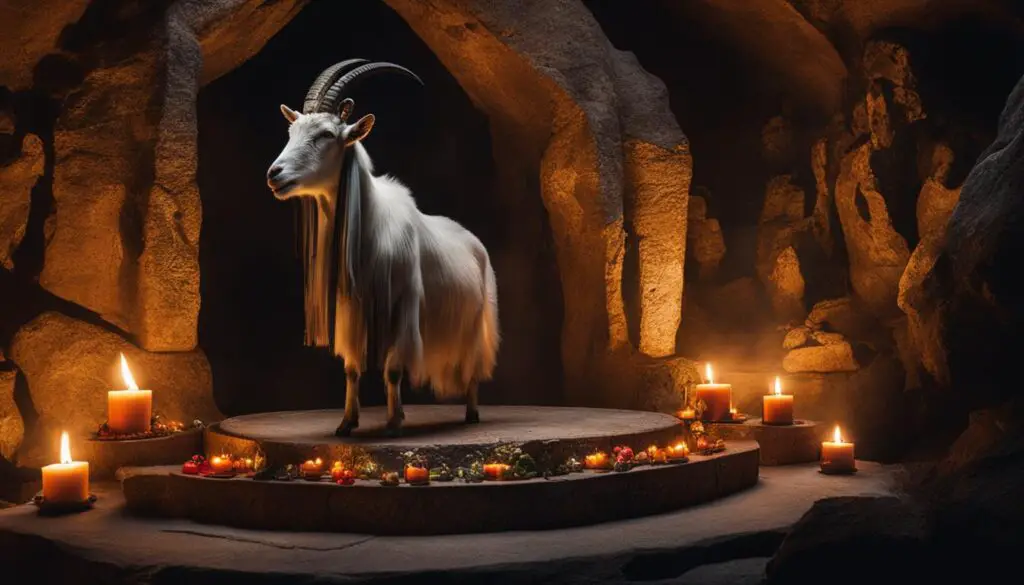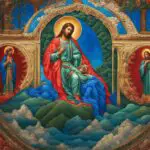The goat holds symbolic significance in the biblical context, with references scattered throughout the scriptures. It represents strong-mindedness, singleness of purpose, and leadership. However, it is often viewed in a negative light due to its association with offensive behavior, going off in its own direction, and the presence of ego. In certain verses, goats are rejected, representing individuals who do not align with the teachings of Christ.
Key Takeaways:
- The goat holds symbolic significance in the Bible, representing strong-mindedness, singleness of purpose, and leadership.
- Goats are often viewed negatively due to their association with offensive behavior and ego.
- References to goats in the Bible highlight the rejection of individuals who do not align with the teachings of Christ.
- The symbolic meaning of goats in the Bible provides insights into faith, spirituality, and moral choices.
The Goat in Leviticus and Yom Kippur
In the book of Leviticus, goats play a prominent role in the rituals of sacrifice and atonement. One specific occasion where goats are central is during the observance of Yom Kippur, also known as the Day of Atonement. During this sacred day, two goats are used in the rituals to symbolize the cleansing of sins.
One of the goats, known as the azazel goat, represents the removal of Israel’s sins. The high priest symbolically places the sins of the people onto this goat, and it is then sent out into the desert, signifying the banishment of the sins from the community. This ritual highlights the concept of atonement and the removal of sin.
To better understand the role of goats in Leviticus and Yom Kippur, let’s take a closer look at the rituals involved:
Sacrifice and Atonement Rituals in Yom Kippur
| Goat | Ritual |
|---|---|
| Azazel Goat | The high priest symbolically places the sins of the people onto this goat, and it is driven out into the desert, representing the removal of sins from the community. |
| Second Goat | This goat is sacrificed as a sin offering, symbolizing the atonement for the sins of the people. |
The rituals surrounding goats in Leviticus and Yom Kippur exemplify the importance of sacrifice and atonement in the biblical context. These practices serve as a means for the Israelites to seek forgiveness for their transgressions and restore their relationship with God.
“The rituals of Yom Kippur involving goats demonstrate the profound significance of repentance and forgiveness in the Jewish faith. The azazel goat, carrying the sins of the people, symbolizes the expulsion of evil and the pursuit of purity. The sacrifice of the second goat emphasizes the atonement for sins, highlighting the redemption and restoration offered through the divine grace.”
The Parable of the Sheep and the Goats
In Matthew 25:31-46, Jesus shares the parable of the Sheep and the Goats. He describes a scene where the Son of Man separates the people, just as a shepherd separates sheep from goats. The sheep are placed on the right, symbolizing eternal life, while the goats are placed on the left, representing eternal judgment.
The parable emphasizes the importance of showing compassion and love for others as a reflection of one’s faith. Jesus states that those who have cared for the hungry, thirsty, naked, sick, and imprisoned have done so unto Him, and they will inherit the kingdom of heaven. On the other hand, those who have neglected these acts of kindness will face eternal punishment.
This parable highlights the distinction between believers and unbelievers based on their actions. It serves as a reminder that true faith is characterized by selfless acts of service and kindness towards others. It also underscores the eternal consequences of one’s choices and the importance of aligning one’s actions with the teachings of Christ.
“Then the King will say to those on his right, ‘Come, you who are blessed by my Father; take your inheritance, the kingdom prepared for you since the creation of the world. For I was hungry and you gave me something to eat, I was thirsty and you gave me something to drink, I was a stranger and you invited me in, I needed clothes and you clothed me, I was sick and you looked after me, I was in prison and you came to visit me.'” – Matthew 25:34-36
Goats in Pagan Religions and Occult Symbolism
Goats have a long history of association with pagan religions and occult symbolism. In ancient Norse and Greek religions, goats were considered sacred and were used in various rituals and ceremonies. They were associated with fertility, abundance, and the divine. The image of a goat-headed figure known as Baphomet has become a prominent symbol in occult practices.
“The goat, which is a nurturer and a protector in our mythology, became a symbol of Satan in Christian beliefs. This association between the goat and evil has led to its demonization in religious contexts.”
It is important to note that the symbolism surrounding goats in pagan religions and the occult differs from their biblical representation. While goats in biblical contexts often have negative connotations, they are not necessarily associated with evil. In pagan beliefs, goats may represent a connection to nature, primal instincts, and the pursuit of knowledge and personal power.
| Symbolism | Pagan Religions | Occult Practices |
|---|---|---|
| Fertility and abundance | Goats were associated with fertility gods and goddesses, and their presence in rituals was believed to bring abundance to crops and livestock. | In occult practices, goats may be linked to rituals aimed at manifesting desires and achieving personal empowerment. |
| Divine connection | Goats were seen as messengers of the gods and were often associated with deities such as Pan and Dionysus. | In occult symbolism, the goat may represent a connection to ancient wisdom and hidden knowledge. |
| Spiritual transformation | Goats were believed to facilitate spiritual growth and transformation, guiding individuals through the journey of self-discovery. | In occult practices, goats may symbolize the process of initiation, self-realization, and spiritual enlightenment. |
It is important to approach the symbolism and representations of goats in pagan religions and occult practices with an understanding of their cultural and historical context. While goats are often associated with darkness and evil in these contexts, it is crucial to recognize that these interpretations may differ from the biblical perspective.
Distinctions Between Sheep and Goats
In the Bible, there are distinct characteristics attributed to sheep and goats. Understanding the differences in their characteristics can provide insights into the symbolism associated with each animal.
Sheep:
- Dependence on the shepherd: Sheep rely on their shepherd for guidance, protection, and provision. They symbolize followers who trust and rely on God.
- Promoters of unity and peace: Sheep are known for their flocking behavior, sticking together and promoting unity among themselves.
- Symbol of gentleness: Sheep are often associated with qualities such as innocence, meekness, and gentleness.
Goats:
- Self-reliance and independence: Unlike sheep, goats are more self-reliant and independent. They represent individuals who rely on themselves rather than seeking guidance from God.
- Stubbornness and defiance: Goats are often seen as stubborn animals, known for their strong-willed nature and resistance to authority.
- Tendency towards destruction: Goats are associated with destructive tendencies, symbolizing individuals who may cause harm or disrupt unity.
These distinct characteristics highlight the contrasting qualities of sheep and goats, shedding light on their symbolic significance in biblical and religious contexts.

| Sheep | Goats |
|---|---|
| Dependence on the shepherd | Self-reliance and independence |
| Promote unity and peace | Stubbornness and defiance |
| Symbol of gentleness | Tendency towards destruction |
The Goat as a Metaphor in Scripture
In biblical context, the goat is often used as a metaphor to represent various qualities and characteristics. In Proverbs and Jeremiah, a male goat is associated with leadership and dignity, assuming command within a flock of sheep. This metaphor highlights the importance of strong-mindedness and singleness of purpose in leadership roles. However, it also serves as a reminder of the inclination towards haughtiness and an inflated ego, cautioning against the negative aspects of leadership.
The metaphor of the goat emphasizes the significance of humility and integrity in guiding others. It calls for leaders to balance their assertiveness with a sense of responsibility and compassion. Just as a strong and determined goat can lead and protect a flock, a true leader must possess the qualities of strength, courage, and wisdom, while always considering the well-being of those they lead.
“A leader is one who knows the way, goes the way, and shows the way.” – John C. Maxwell
By employing the goat as a metaphor, biblical writers seek to provide guidance on effective leadership, encouraging individuals to embody the positive qualities associated with goats while avoiding the pitfalls of pride and arrogance. This metaphor serves as a timeless reminder for leaders in both religious and secular contexts to lead with humility, dignity, and a genuine concern for the welfare of others.
Table: Qualities Associated with Goat as a Metaphor
| Qualities | Symbolic Significance |
|---|---|
| Leadership | Represents the ability to guide and protect others |
| Dignity | Accentuates the importance of maintaining integrity and self-respect |
| Haughtiness | Serves as a cautionary reminder against arrogance and ego |
Goats in Jewish Religious Practices
Goats play significant roles in Jewish religious practices, particularly in the observance of Yom Kippur, the holiest day in the Jewish calendar. During this solemn occasion, one goat is chosen as a scapegoat, symbolizing the removal of sins from the people. The scapegoat, also known as the azazel goat, is a central figure in the rituals surrounding atonement and redemption.

The scapegoat ritual involves the high priest confessing the sins of the people over the goat, transferring their transgressions onto the animal. Once the sins are symbolically placed upon the azazel goat, it is taken to a desolate area or driven out into the wilderness, signifying the banishment of evil and the removal of the people’s sins. This ritual represents the cleansing of the community and the restoration of purity.
It is important to note that the term “azazel” has been associated with a desert demon or force of evil. The use of a goat in this context reflects the belief that the sins of the people are being placed upon a symbolic representation of the embodiment of evil. Through the rituals involving goats, Jewish religious practices emphasize the concepts of sin, redemption, and the role of sacrifice in seeking forgiveness and spiritual renewal.
Goat Symbolism in Non-Biblical Contexts
While goats hold significant symbolism in biblical contexts, their representation extends beyond religious narratives. In various non-biblical contexts, goats have played prominent roles and acquired symbolic meanings. One such association is with pagan worship and mythology, where goats were revered and worshipped.
Among the ancient Norse and Greek religions, goats were closely associated with satyrs, mythical creatures with goat-like features. These satyrs were often depicted as lively and mischievous, representing fertility and the untamed forces of nature. The goat’s presence in pagan worship symbolized the connection between humanity and the wilderness, emphasizing the primal and instinctive aspects of life.
“The goat’s presence in pagan worship symbolized the connection between humanity and the wilderness, emphasizing the primal and instinctive aspects of life.”
The symbolism attached to goats in non-biblical contexts aligns with their negative connotations in religious narratives. The association between goats and satyrs highlights their connection to unbridled desires and indulgence. This juxtaposition between the sacred and the profane further reinforces the contrasting perspectives on goats and their symbolic interpretations.
Goat Symbolism in Pagan Worship
The goat holds deep symbolism in pagan worship, often associated with primal and natural forces. In ancient Norse and Greek religions, goats were revered and worshipped as symbols of fertility, abundance, and connection to the wilderness. The image of satyrs, half-man and half-goat creatures, exemplified the untamed and mischievous aspects of nature.

“The image of satyrs, half-man and half-goat creatures, exemplified the untamed and mischievous aspects of nature.”
Goats in pagan worship represented the intersection between humanity and the wild, celebrating the primal and instinctual aspects of life. Their association with fertility and abundance emphasized the cyclical nature of natural processes and the interconnectedness of all living beings.
Goat Symbolism in Pagan Mythology
The symbolism of goats extended beyond worship and into pagan mythology. They often represented various deities and played significant roles in folklore and legends. The Greek god Pan, depicted as a goat-legged deity, embodied fertility, musicality, and the untamed wilderness. Similarly, the Norse god Thor, associated with strength and protection, possessed chariots pulled by goats.
“The goats’ representation of deities in pagan mythology exemplified specific qualities such as fertility, strength, and protection.”
Through their association with deities and mythological figures, goats in pagan mythology reflected the diverse attributes and qualities attributed to them. The imagery and symbolism surrounding goats in pagan contexts provide insights into the beliefs, values, and practices of ancient civilizations.”
| Goat Symbolism in Non-Biblical Contexts | |
|---|---|
| Symbolism | Goats hold significant symbolism in non-biblical contexts, particularly in pagan worship and mythology. |
| Pagan Worship | In ancient Norse and Greek religions, goats were revered and worshipped, often associated with satyrs, mythical creatures with goat-like features. |
| Pagan Mythology | Goats represented various deities and played significant roles in pagan folklore and legends, exemplifying specific qualities such as fertility, strength, and protection. |
The Representation of Satan as a Goat
The representation of Satan as a goat has deep-rooted origins in pagan and occult beliefs. This imagery has been associated with the figure of Baphomet, a goat-headed deity often depicted in occult symbolism. Seen as a symbol of rebellion against divine authority, the goat represents evil and darkness.
The goat’s association with Satanism and the occult has contributed to its negative connotations in religious contexts. The use of the goat as a symbol reinforces the idea of a malevolent force that opposes divine goodness. It serves as a visual representation of the rebellious and destructive aspects of evil.
“The symbolism of Satan as a goat can be traced back centuries, appearing in various forms across different cultures and traditions. The goat’s appearance in occult symbolism and its association with Satanism reflects the long-standing belief in the figure of the devil as a powerful force of darkness and temptation.”
Throughout history, the representation of Satan as a goat has served as a powerful symbol in religious and spiritual narratives. It portrays the embodiment of evil, rebellion, and opposition to divine authority. The imagery surrounding the goat in these contexts underscores its negative connotations and its role as a visual representation of the forces of darkness.

Table: The Symbolism of Satan as a Goat
| Symbol | Meaning |
|---|---|
| Baphomet | Satanic deity depicted with a goat’s head, representing rebellion and opposition to divine authority. |
| Occult Symbolism | Goat imagery used in occult practices to symbolize evil, darkness, and temptation. |
Conclusion
The goat holds symbolic significance in biblical context, representing qualities such as strong-mindedness, singleness of purpose, and leadership. However, it is often viewed negatively due to its association with offensive behavior and ego.
Goats are prominently featured in rituals of sacrifice and atonement, playing a vital role in cleansing sins and seeking redemption. In these rituals, goats symbolize the transfer of human sins onto the animal, serving as a sacrificial offering to appease God.
The parable of the Sheep and the Goats further highlights the distinction between believers and unbelievers based on their actions. The parable emphasizes the importance of compassion, love, and kindness towards others as a reflection of one’s faith. It underscores the consequences of one’s choices and actions in relation to the teachings of Christ.
Additionally, goats hold symbolic meaning in pagan religions and occult practices. The negative connotations associated with goats in religious narratives are reinforced by the representation of Satan as a goat, such as the figure of Baphomet in occult symbolism. These representations symbolize rebellion against divine authority and the embodiment of evil.
In conclusion, the symbolism and representations of goats in the Bible and other contexts provide insights into various aspects of faith, spirituality, and moral choices. They highlight the complexities of human nature, the struggle between good and evil, and the importance of aligning one’s actions with one’s religious beliefs.
FAQ
What is the symbolic significance of the goat in biblical context?
The goat represents strong-mindedness, singleness of purpose, and leadership, but is often viewed negatively due to its association with offensive behavior and ego.
How are goats featured in the rituals of sacrifice and atonement in the book of Leviticus?
Goats are prominently featured in the rituals of sacrifice and atonement in the book of Leviticus, particularly during the observance of Yom Kippur. Two goats were used, with one representing the removal of Israel’s sins.
In the parable of the Sheep and the Goats, what do sheep and goats symbolize?
In the parable of the Sheep and the Goats, sheep symbolize believers who will receive eternal life, while goats represent unbelievers who will face eternal judgment.
What is the association of goats with pagan religions and occult symbolism?
Goats have been associated with pagan religions and occult symbolism. They were used in worship and had symbolic meanings in various ancient religions. The goat-headed figure known as Baphomet has been adopted as a symbol of Satanism.
How do sheep and goats differ in their characteristics?
Sheep are portrayed as dependent on their shepherd, symbolizing followers who trust and rely on God. Goats, on the other hand, are seen as self-reliant and stubborn, representing individuals who rely on themselves rather than seeking guidance from God.
What does the goat as a metaphor in Scripture represent?
The goat as a metaphor in Scripture represents leadership and dignity, but also highlights the inclination towards haughtiness and an inflated ego. It emphasizes the importance of humility and integrity in leadership roles.
How are goats involved in Jewish religious practices?
Goats play significant roles in Jewish religious practices, particularly during Yom Kippur. One goat is designated as a scapegoat, representing the removal of sins from the people.
How are goats symbolized in non-biblical contexts?
In non-biblical contexts, goats are associated with pagan worship and mythology. They were revered and worshipped in various ancient religions, such as Norse and Greek.
What is the representation of Satan as a goat?
The representation of Satan as a goat can be traced back to pagan and occult beliefs. The goat-headed figure known as Baphomet has been associated with Satanism and rebellion against divine authority.







